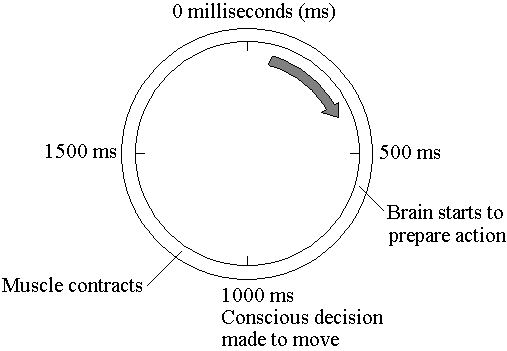Is Our Experience a Construction of the Apparatus of our
Brain?
1. “Color phi.” If two closely spaced dots are alternately and
briefly lighted in rapid succession, a single spot is seen to move between the
two. If the two spots are different colors, a moving spot is seen that suddenly
changes its color at the halfway point. (The two spots are lit for 150 msec
each, with a 50 msec gap between them.)

How do we know suddenly to change the color before the second flash occurs?
2. The “cutaneous rabbit". A person’s arm is mechanically tapped in different
places (e.g. 5 taps on the wrist, then 2 near the elbow, then 3 more on the
upper arm). The person reports that the taps seem to travel in a regular
sequence over equally spaced points up the arm, as if a little animal were
hopping along the arm. (Nasa diagram)
How do we know that after the 5 taps on the wrist, there were going
to be some taps near the elbow? (If only
the wrist is tapped then all of the taps are felt at the wrist.)
3. A person’s left cortex is
stimulated before his left hand is stimulated. We expect that he will feel two
tingles: first his right hand (cortically induced), and then his left hand (due
to the additional distance, close to a meter, the nerve impulses must travel
from the hand to the brain.) In fact, however, the person reports exactly the
opposite: "first left, then right."
4. Subjective delay of consciousness of intention. A person is asked to make a
"spontaneous" decision to flex one hand at the wrist while noting the position
of a clock. The reported time of the conscious decisions lagged up to 350 - 400
msec behind the onset of a "readiness potential" recorded from scalp electrodes.

Diagram from Carver, Rita,
Exploring Consciousness
5. “Precognitive carousel.” A person looks at slides and presses
a button when she wants to see the next. The button is a fake - what moved the
slides was electrical activity in the brain’s cortex. Subjects reported that
they were surprised when the slides moved just as they were "about to" push the
button.
6. A person is instructed to push a button upon feeling a touch upon his arm.
200 msec after being touched, the person pushes the button, then apologizes for
accidentally pushing the button. Due to normal
reaction time, he pushed the button 200 msec after being touched. But 300 msec
later, his brain’s sensory cortex was electrically stimulated to mask the
conscious perception of the touch. He responded properly to a stimulus he did
not perceive.
Does decision-making occurs prior to consciousness with conscious intent at most
having an "executive veto" role in decision making? (Note: the “veto” has its
own readiness potential!)
How does the brain’s apparatus construct our conscious experience? See Dennett
and Kinsbourne for their two models:
The Cartesian Theater (CT). All sensory information converges to one point in
the brain from which our stream of consciousness is generated.
The Multiple Drafts Model (MDM). There is no central point. Localized
discriminations in different areas of the brain are not represented for a more
central discriminator (thus avoiding a homunculus). Our stream of consciousness
is a number of parallel streams of conflicting and continuously revised contents
(drafts) where no single one is the true version. Also the objective temporal
properties of particular states do not necessarily determine the temporal
properties of subjective experience.
What does this have to do with free will?
In Mapping the Mind, Rita Carver states, “When we look inside the brain
we see that our actions follow from our perceptions and our perceptions are
constructed by brain activity. In turn, that activity is dictated by a neuronal
structure that is formed by the interplay of our genes and the environment.”
References:
Carver, Rita, Mapping the Mind, University of California Press, 1998.
Carver, Rita, Exploring Consciousness, University of California Press,
2002.
Dennett, Daniel and Kinsbourne, Marcel, “Time and the Observer: The Where and
When of Consciousness in the Brain,” in Behavioral and Brain Sciences
(1996) [available at
http://www.bbsonline.org/documents/a/00/00/04/50/ ]
Dennett, Daniel, Consciousness Explained, Little Brown & Company, 1991.
Gazzaniga, Michael S., The Mind’s Past, University of California Press,
1998.
Gazzaniga, Michael S., "The Split Brain Revisited," Scientific American,
July 1998.
Kornhuber, H. H., "Cerebral Cortex, Cerebellum, and Basal Ganglia: An
Introduction to Their Motor Functions," in The Neurosciences, Third Study
Program, eds. F. O. Schmitt and F. G. Worden (Cambridge, Mass.:
Massachusetts Institute of Technology, 1973), pp. 267-80.
Pickover, Clifford A., Time: A Traveler’s Guide, Oxford University Press,
1998.
Return to Honors PS1500 home page
Last modified:
Monday, March 21, 2005 11:47 AM

